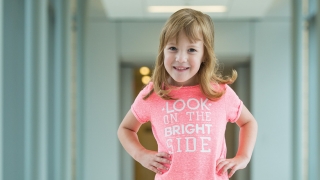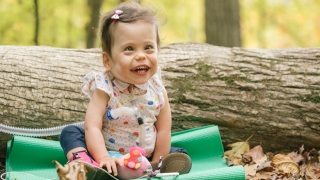The journey for babies with bronchopulmonary dysplasia (BPD) — also called chronic lung disease of infancy — can be long and complex. In this video, neonatologists and pulmonologists from the Newborn and Infant Chronic Lung Disease (NeoCLD) Program at Children's Hospital of Philadelphia (CHOP) explain what causes BPD in infants, bronchopulmonary dysplasia treatment options, care in the N/IICU, the benefits of tracheostomy surgery, the team required to manage chronic lung disease in neonates, long-term care, and the support services CHOP offers families. You'll also hear from a family whose child is a patient of the program. A comprehensive program like this is vital to the long-term survival of these most vulnerable patients.
Transcript
Bronchopulmonary Dysplasia: Care for Chronic Lung Disease in Infants
Explaining Bronchopulmonary Dysplasia: Newborn and Infant Chronic Lung Disease Program
Kathleen Gibbs, MD: We're seeing more survivors of prematurity and more of the extremes of prematurity.
Stamatia Alexiou, MD: Bronchopulmonary Dysplasia is really the abnormal growth and development of the lungs due to prematurity. Any patient that's born premature really is at risk for the disease.
Kathleen Gibbs, MD: It is because they were born at a very critical phase of lung development. And they were either exposed to mechanical ventilation or as they were growing, their lungs, not being in the womb and being outside, didn't develop as they should.
Stamatia Alexiou, MD: BPD can be life threatening.
Kristen, Mom: I hit 24 weeks and my water broke. So, they admitted me into our local hospital and didn't go into labor until 32 weeks. We had a C-section and he was not able to breathe on his own at all. So, right away, he had to be intubated and then, they whisked him off to the NICU, where he remained for almost two and a half months. Our local hospital was great, but they took us to a point where that was the max they could take us to. So, we knew we needed to seek other options. Through the help of some of our doctors there, we reached out to Dr. Zhang over at CHOP. She was just a godsend.
Huayan Zhang, MD: The Newborn and Infant Chronic Lung Disease Program, it’s a specialty program that we started in the fall of 2010.
Sara B. DeMauro, MD: There are very few programs in the country or even in the world that have the specialized focused care for infants with chronic lung disease, that we can offer here. It's important to come someplace where the whole team has experience with the most severe lung disease that an infant can have.
Caring for your baby
Stamatia Alexiou, MD: Some of the factors that influence the direction of how we treat patients with BPD, it reflects the severity of their disease and how premature they are. The majority of patients will require some form of respiratory support, whether it's just supplemental oxygen, or something a little bit more intense like mechanical ventilation. So that's – that's pretty standard therapy for all patients that are a part of our Chronic Lung Disease Program. After that, it really just does depend on what other organ systems are affected.
The biggest challenge in treating patients with BPD is that no two patients are alike. The disease really isn't a one-size-fits-all, and the treatment for one patient may not work for another patient. And so, we really have to individualize treatment based on again, what we're seeing in the patient.
Sara B. DeMauro, MD The NICU at CHOP really is one of the biggest and best NICU's in the world. We have neonatologists, doctors who take care of babies in the hospital. We have lung doctors on our team. We have heart doctors, cardiologists on our team. We also have a lot of therapists. We're unique in that we have the resources to support not only the medical needs of the baby, but the psychological needs of the baby and the family, occupational therapy, physical therapy.
Huayan Zhang, MD: The specialty here is across the board from best at nursing, to respiratory therapists, to the developmental therapists, to all the subspecialty consultant. That experience, you can't get from a regular NICU. This is a special patient population. They're chronically ill and they can be critically ill.
We have taken care of more than 400 patients like this, with the most severe Bronchopulmonary Dysplasia. And that experience is hard to get from a – from anywhere else.
Paul, Dad: CHOP is about three and a half hours from us. For the distance that you go for your kids, it's not that far.
Overcoming challenges as a team.
Stamatia Alexiou, MD: Well, of course, we expect the best-case scenario for every patient who's diagnosed with BPD. The reality is that some challenges will be met going forward.
Kathleen Gibbs, MD: The babies that we get are a specific subset of babies with severe BPD and these infants are more likely to have difficulties with development, more likely to have high blood pressure in the lungs, and do have higher rates of death compared to children who don't have severe BPD.
The good news about BPD is that by and large, with time, growth and supporting the physiologic needs of the baby, they can outgrow it.
Stamatia Alexiou, MD: Neurodevelopmentally, there will be some lag, and again, that's where we work with physical therapists, speech therapists, occupational therapists, to make sure that by the time they reach their school ages, that they're essentially caught up.
Kathleen Gibbs, MD: We want to get our patients home. We want to get them with their families as healthy as they can possibly be. We want to make sure that we provide them every opportunity to thrive.
Stamatia Alexiou, MD: The journey in a patient that's born with Bronchopulmonary Dysplasia can be a long one. It can be a complex one. It can be an overwhelming and intimidating one. But you just got to take it one step at-a-time and one-day-at-a-time.
Advantages of a trach
Sara B. DeMauro, MD: When babies are working very, very hard to breathe, they spend all of their focus and all of their energy on breathing. Many of the children on our team ultimately need a tracheostomy which is a surgical procedure to put an airway in the neck so that we can continue to support their breathing. The key to having a tracheostomy is that it allows babies to have their faces free of equipment, which means they can have their hands and they can start to play, and they can put their hands in their face. They can suck their thumbs; they can play with their noses. They can do things that babies are supposed to be doing and it doesn't interfere with their ability to breathe. And that's hugely important as babies grow.
Kathleen Gibbs, MD: After a tracheostomy, the ability to do physical therapy, occupational therapy, speech therapy is actually much easier and safer for the baby, and better tolerated, than to not have a tracheostomy. Babies who have a trach placed, typically have it in place for at least a few years before it's safe to actually take the tracheostomy out.
Kristin: November 3rd, he received his surgeries and that was really the turning point.
Paul: You saw on the chart - his weight just dramatically skyrocketed –
Kristin: Skyrocketed.
Paul: And … was on his way to recovery.
Long-term outlook
Kathleen Gibbs, MD: Preparing for long-term follow-up really starts from the very beginning when we sit down and say, "All right, here's our roadmap for your hospitalization." And then, those updates over the course of time are given. "All right, here's where we are. Here's what it's going to take to go home and here's what we think you're going to go home with."
Sara B. DeMauro, MD: But the journey doesn't end when you walk out the door of CHOP. In some ways, the journey's just beginning. We remain a part of that family's journey and we continue to see that baby back in our program for many years, sometimes every few months in the beginning. And then, every year or so as the child gets older
Patients in our Neonatal Follow-up Program for years after they leave the hospital.
Kathleen Gibbs, MD: Long-term, we're looking at months, if not years of needing extra support breathing.
Stamatia Alexiou, MD: The NICU's really great at training parents to make sure that they're ready to adapt to any challenges that they may face in terms of tracheostomy tube management, ventilator management, issues with medications.
Paul: When we got home, we knew that we were gonna have the training that CHOP provided us to be able to take care of our son and kind of just know what we have to do in case of an emergency or just everyday care.
Huayan Zhang, MD: Charlie, when we met him, he's basically failing to grow and cannot do anything else but breathe. By the time he left, he really was a lovely baby, interactive with everybody, already taking bottle feeding by that time. And went home and continue to thrive.
Kristen: You know, he was strictly G tube fed and now, he is strictly –
Paul: A slice of pizza.
Kristin: Yeah, he could eat probably a third of a pie. He eats everything by mouth, he drinks by mouth. He's speaking. I think despite everything that happened with Charlie, our hopes for Charlie are no different from any other parent's hopes for their children. And a positive, successful healthy lifestyle which he'll have, and just to continue growing, getting better and better every day, in every way.
Kathleen Gibbs, MD: The Children's Hospital of Philadelphia is an unbelievable place, an incredible group of people who care about treating children, who have the resources necessary to do that, come together in a collaborative way, to figure out how to individualize a treatment plan for that child, whatever it takes.
Sara B. DeMauro, MD: This journey is hard. Parents come here because they have a very, very sick baby. They're not alone. We have an enormous staff of people who've seen this before and will see it again. And we will support them, and we will help take care of the baby and we will help take care of the family throughout their journey.
Topics Covered: Infant Chronic Lung Disease
Related Centers and Programs: Newborn and Infant Chronic Lung Disease Program, Division of Neonatology, Newborn/Infant Intensive Care Unit (N/IICU)


